AVOCATIONS — A Magazine of Hobbies and Leisure, December 1937
A PENNY FOR YOUR BANK
by Norman Sherwood
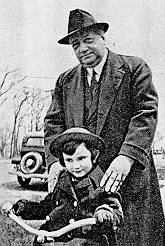
And in Algernon’s case, let me assure you that the receiving of the coin was the best part of the entire deal—His Bank was a marvelously fashioned contraption of cast iron enameled in gay colors—somewhat the worse for wear, to be sure—but a humdinger none the less. It represented a fort, in the front of which was a target—a gun trained on the fort shot the coin into it, hitting the target with unfailing and deadly accuracy—every time—and warming the heart of the amateur cannoneer with a sense of his own competence and infallible marksmanship.
AND here in a nutshell is the real explanation, the psychological "lowdown" on the almost unbelievable popularity that these old toy mechanical Penny Banks enjoyed for a period of over thirty years—from just after the close of the Civil War until the "fin de Siecle," the beginning of the twentieth century. (True, a few were made, perhaps, without patent dates, before the Halls excelsior of 1869 and many were made on into the early years of the present century—in fact three mechanical banks—the elephant who throws a penny over his head—the trick dog who jumps through the hoop—and the trick monkey who puts his penny into the organ grinder’s organ—are still manufactured—but to all intents and purposes the Civil War to the Spanish War is the span of the mechanical bank).
 It
was the fact that these banks unfailingly made their proud possessors feel
competent, accurate, dominating—that they tickled their sense of importance
and superiority—which made them so popular with their young owners. They
always bit the Bullseye—or rang the Bell—sometimes, in fact, they did both—they
made the animals perform or the cow "kick the bucket" or the dog
swallow the penny.
It
was the fact that these banks unfailingly made their proud possessors feel
competent, accurate, dominating—that they tickled their sense of importance
and superiority—which made them so popular with their young owners. They
always bit the Bullseye—or rang the Bell—sometimes, in fact, they did both—they
made the animals perform or the cow "kick the bucket" or the dog
swallow the penny.
SAVING, of course, was virtuous—gave one a sense of being a little Rollo, or, if the gentler sex made one a candidate for the role of Elsie Dinsmore in the Christmas Play—but the Real Fun, believe me, was in putting the penny into the bank. The virtues and rewards of thrift came afterward and were secondary in importance and incidental to the real thrill of what took place at the moment of acquisition. In fact, there has never been any real doubt in my mind as to what made these banks so popular with the youngsters themselves. Everyone knows it is the real user (the ultimate consumer) who determines the popularity of any article—and not until Young America became so bored and blasé that the fun of putting money into mechanical banks was fun no longer (and with the miracles of electrical trains and talking dolls to dim the allure of banks, who can blame them?) that these old standbys or the seventies, eighties, and nineties definitely declined and fell (or rose) into the attic—the store room—or the junk pile.
But, fortunately, within twenty-five years of their final loss of their hold on children’s hearts, these banks started to exert an appeal to the hearts of grown ups—Staid Bankers—Captains of Industry—Professional Men—even Economic Royalists—began to collect these childhood banks—and since twenty-five years is a long time in this rapidly moving age of ours, and since we do not hold and cherish discarded things as we once did, the Collector found the remaining specimens of all save the commonest or most popular kinds of banks amazingly few indeed. I estimate not over one or two percent of all the mechanical banks manufactured have survived down to the present day. If you know something about banks—and an increasingly large number of collectors and dealers are beginning to "know their banks"—you may say: "How do you account for so many Halls Excelsiors, Eagle and Eaglettes, or Creedmores, or William Tells, etc., still existing? The answer is not difficult. Some of these banks were manufactured year in and year out in such amazingly large numbers that even one or two percent of the total would run into very large numbers. Banks which were made in large numbers over a long period are still plentiful and worth only a very few dollars indeed. But just try to find a specimen of some of the banks made briefly and at the beginning or end of the period—and you will discover that money will not buy them. I know of only one Bull and Bear Bank—and in spite of wide publicity I can name only two Tall Thin Tellers behind Three Sided Latticed Grill in collections, although I admit there may be others I do not know about. In fact, there are a number of banks—not one or two, probably twenty-five or more—of which only one or two specimens have to my knowledge been turned up, and also there are a few, known from pictures and descriptions in catalogs or trade journals, such as the Freedmans Bank and Presto—a mouse jumping out of the roof of a building (not to be confused with the more common Presto Bank)—of which no complete specimen has yet been discovered by a collector. Also, I can state with conviction that there are some authentic factory made mechanical banks which were duly advertised and sold of which, with all the widespread interest in banks, and publicity, we are as yet completely unaware. Proof of this amazing statement? Well, within the last thirty days I have found a catalog only forty years old advertising a bank up to that moment entirely unknown to any collector or dealer of my acquaintance—yes, and in the same place I found the bank itself—it was at the end of a very long trail of searching and researching but the find richly repaid in both spiritual and financial satisfaction for the effort expanded.
Do you wonder that old mechanical banks have become a leading collector’s item? My only feeling is one of wonder that they are not even more sought-after and popular and that it took them so long to come into their own.
TEXT UNDER PHOTOS:
Top: Atlas Supporting The World bank. Center: Confectionery Store bank.
Bottom: The Giant bank.
Norman Sherwood and his daughter Anne, age 4 years, 4 months.


Left to right: Pig in the High Chair, Jonah and the Whale (very popular), and The Rooster bank.

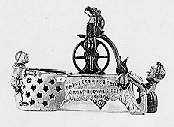

Left to right: Girl Skipping Rope, a most elaborate and desirable bank:
Initiation or First Degree bank, an item the author is lacking in his
collection.
Professor Pugfrog’s Great Bicycle Feat Bank.
Milking Cow bank.
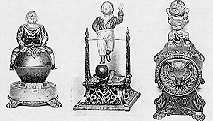

A trio of action banks—Left to right: The Whirling Clown on Globe, Boy on
Trapeze and Cat and Mouse.
The Horse Race bank.
Reclining Chinaman bank.
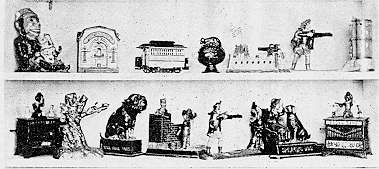
A shelf of banks including several rarities from a well known collection. The third bank from the right on upper shelf is The Fort bank in which Algernon was highly interested.
n
Another article on the interesting subject of Penny Banks will appear in an early issue.—Ed.
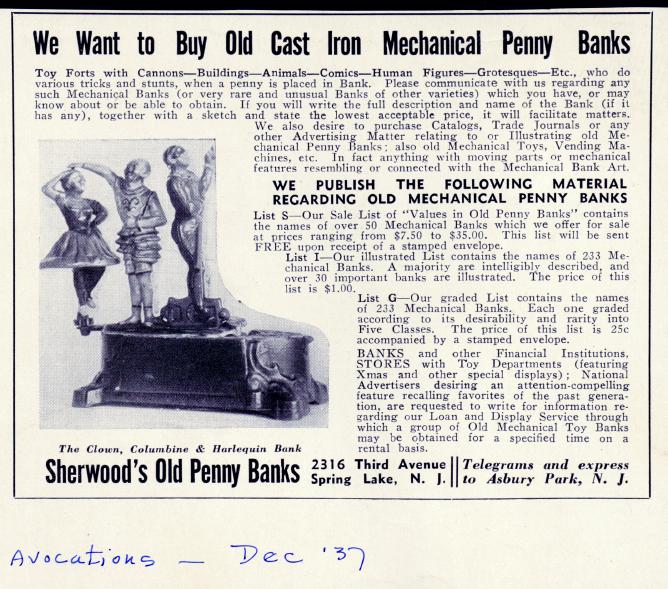
AVOCATIONS, December 1937
We Want to Buy Old Cast Iron Mechanical Benny Banks
Toy Forts with Cannons — Buildings — Animals — Comics — Human Figures
— Grotesques — Etc., who do various tricks and stunts, when a penny is placed in
Bank. Please communicate with us regarding any such Mechanical Banks (or very
rare and unusual Banks of other varieties) which you have or may know about or
be able to obtain. If you will write the full description and name of the Bank
(if it has any), together with a sketch and state the lowest acceptable price,
it will facilitate matters.
We also desire to purchase Catalogs, Trade Journals or
any other Advertising Matter relating to or Illustrating old Mechanical Penny
Banks; also old Mechanical Toys, Vending Machines, etc. In fact anything with
moving parts or mechanical features resembling or connected with the Mechanical
Bank Art.
WE PUBLISH THE FOLLOWING MATERIAL
REGARDING OLD MECHANICAL PENNY BANKS
List S — Our Sale List of "Values
in Old Penny Banks" contains the names of over 50 Mechanical Banks which we
offer for sale at prices ranging fron $7.50 to $35.00. This list will be sent
FREE upon receipt of a stamped envelope.
List I — Our illustrated List contains the names of 233 Mechanical banks.
A Majority are intelligibly described and over 30 important banks are
illustrated. The price of this list is $1.00.
List G — Our graded List contains the names of 233 Mechanical Banks. Each
one graded according to its desirability and rarity into Five Classes. The price
of this list is 25c accompanied by a stamped envelope.
BANKS and other Financial Institutions, STORES with Toy
Departments (featuring Xmas and other special displays; National Advertisers
desiring an attention-compelling feature, are requested to write for information
regarding our Loan and Display Service through which a group
of Old Mechanical Toy Banks may be obtained for a specific time on a rental
basis.
Sherwood's Old Penny Banks
2316 Third Avenue
Spring Lake, N. J.
Telegrams and express to Asbury Park, N. J.
